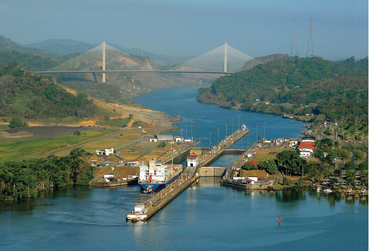 One Set of Locks in the Panama Canal
One Set of Locks in the Panama Canal The Panama Canal is a lock system that lifts a ship up 85 feet to the main level of the Panama Canal through a series of three “locks” or watertight chambers. After traveling through Lake Gatun, a second series of three locks drop the ship back down to sea level on the other side.
In 1914, the Panama Canal changed the course of history. Since then, it has been so influential in the shipping industry that the term “Panamax” was coined to signify that the ship was the maximum size to fit through the Panama Canal. For decades shipbuilders stayed within the Panamax size specifications and wouldn’t build anything larger.
The $5.2 billion expansion project of the Panama Canal is creating a new lane which connects the Pacific Ocean to the Atlantic Ocean. The new locks will be thirty percent larger than the current locks in order to allow ships larger than Panamax to travel through the Panama Canal. To give you an idea of the size, you can fit three Empire State Buildings end-to-end within its chambers.
To give you an idea of the scope of this 7-year project (for people like me who don’t understand what it takes to create a new bike, let alone an entire new shipping channel), here are some of the pieces of the Panama Canal puzzle.
- Fifty million cubic meters of land had to be extracted using explosives and moved via truck in order to make the new canal lane possible.
- Lake Gatun had to be raised. (Every try to raise an entire lake!?!)
- The two existing lanes are being dredged in order to deepen and widen them, which will allow ships larger than Panamax to travel through the Panama Canal.
When complete in 2015, the expansion will double the ship capacity and allow larger ships to pass through.
No trip to Panama is complete without a trip to the Panama Canal. When you come to Panama, make sure you plan your trip to the Panama Canal on a late afternoon during the week when it's not raining. This will help you get maximum enjoyment without the hassle of weekend crowds.


 RSS Feed
RSS Feed